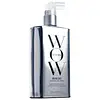What's inside
What's inside
 Key Ingredients
Key Ingredients

No key ingredients
 Benefits
Benefits

 Concerns
Concerns

No concerns
 Ingredients Side-by-side
Ingredients Side-by-side

Water
Skin ConditioningDipropylene Glycol
HumectantPolysilicone-29
Silicone Quaternium-18
EmollientGlycerin
HumectantTrideceth-6
EmulsifyingChamomilla Recutita Flower Extract
MaskingCalendula Officinalis Flower Extract
MaskingPotassium Sorbate
PreservativePhenoxyethanol
PreservativeTrideceth-12
EmulsifyingSodium Benzoate
MaskingChlorphenesin
AntimicrobialPotassium Benzoate
PreservativeDisodium EDTA
Citric Acid
BufferingWater
Skin ConditioningC13-15 Alkane
SolventEthylhexyl Olivate
Skin ConditioningPolyacrylate-13
Glycerin
HumectantSqualane
EmollientBrassica Campestris/Aleurites Fordi Oil Copolymer
Skin ConditioningBeta Vulgaris Root Extract
Skin ConditioningArtocarpus Heterophyllus Fruit Extract
Skin ConditioningTocopherol
AntioxidantDimethicone
EmollientCetearyl Alcohol
EmollientArginine
MaskingPolysorbate 20
EmulsifyingSorbitan Isostearate
EmulsifyingEthylhexylglycerin
Skin ConditioningCaprylic/Capric Triglyceride
MaskingPolyisobutene
Lactobacillus Ferment
Skin ConditioningParfum
MaskingTrisodium Ethylenediamine Disuccinate
Phenoxyethanol
PreservativeCitric Acid
BufferingLimonene
PerfumingAlpha-Isomethyl Ionone
PerfumingGeraniol
PerfumingHydroxycitronellal
PerfumingLinalool
PerfumingCitronellol
PerfumingCinnamyl Alcohol
PerfumingWater, C13-15 Alkane, Ethylhexyl Olivate, Polyacrylate-13, Glycerin, Squalane, Brassica Campestris/Aleurites Fordi Oil Copolymer, Beta Vulgaris Root Extract, Artocarpus Heterophyllus Fruit Extract, Tocopherol, Dimethicone, Cetearyl Alcohol, Arginine, Polysorbate 20, Sorbitan Isostearate, Ethylhexylglycerin, Caprylic/Capric Triglyceride, Polyisobutene, Lactobacillus Ferment, Parfum, Trisodium Ethylenediamine Disuccinate, Phenoxyethanol, Citric Acid, Limonene, Alpha-Isomethyl Ionone, Geraniol, Hydroxycitronellal, Linalool, Citronellol, Cinnamyl Alcohol
 Reviews
Reviews

Ingredients Explained
These ingredients are found in both products.
Ingredients higher up in an ingredient list are typically present in a larger amount.
Citric Acid is an alpha hydroxy acid (AHA) naturally found in citrus fruits like oranges, lemons, and limes.
Like other AHAs, citric acid can exfoliate skin by breaking down the bonds that hold dead skin cells together. This helps reveal smoother and brighter skin underneath.
However, this exfoliating effect only happens at high concentrations (20%) which can be hard to find in cosmetic products.
Due to this, citric acid is usually included in small amounts as a pH adjuster. This helps keep products slightly more acidic and compatible with skin's natural pH.
In skincare formulas, citric acid can:
While it can provide some skin benefits, research shows lactic acid and glycolic acid are generally more effective and less irritating exfoliants.
Most citric acid used in skincare today is made by fermenting sugars (usually from molasses). This synthetic version is identical to the natural citrus form but easier to stabilize and use in formulations.
Read more about some other popular AHA's here:
Learn more about Citric AcidGlycerin is already naturally found in your skin. It helps moisturize and protect your skin.
A study from 2016 found glycerin to be more effective as a humectant than AHAs and hyaluronic acid.
As a humectant, it helps the skin stay hydrated by pulling moisture to your skin. The low molecular weight of glycerin allows it to pull moisture into the deeper layers of your skin.
Hydrated skin improves your skin barrier; Your skin barrier helps protect against irritants and bacteria.
Glycerin has also been found to have antimicrobial and antiviral properties. Due to these properties, glycerin is often used in wound and burn treatments.
In cosmetics, glycerin is usually derived from plants such as soybean or palm. However, it can also be sourced from animals, such as tallow or animal fat.
This ingredient is organic, colorless, odorless, and non-toxic.
Glycerin is the name for this ingredient in American English. British English uses Glycerol/Glycerine.
Learn more about GlycerinPhenoxyethanol is a preservative that has germicide, antimicrobial, and aromatic properties. Studies show that phenoxyethanol can prevent microbial growth. By itself, it has a scent that is similar to that of a rose.
It's often used in formulations along with Caprylyl Glycol to preserve the shelf life of products.
Water. It's the most common cosmetic ingredient of all. You'll usually see it at the top of ingredient lists, meaning that it makes up the largest part of the product.
So why is it so popular? Water most often acts as a solvent - this means that it helps dissolve other ingredients into the formulation.
You'll also recognize water as that liquid we all need to stay alive. If you see this, drink a glass of water. Stay hydrated!
Learn more about Water